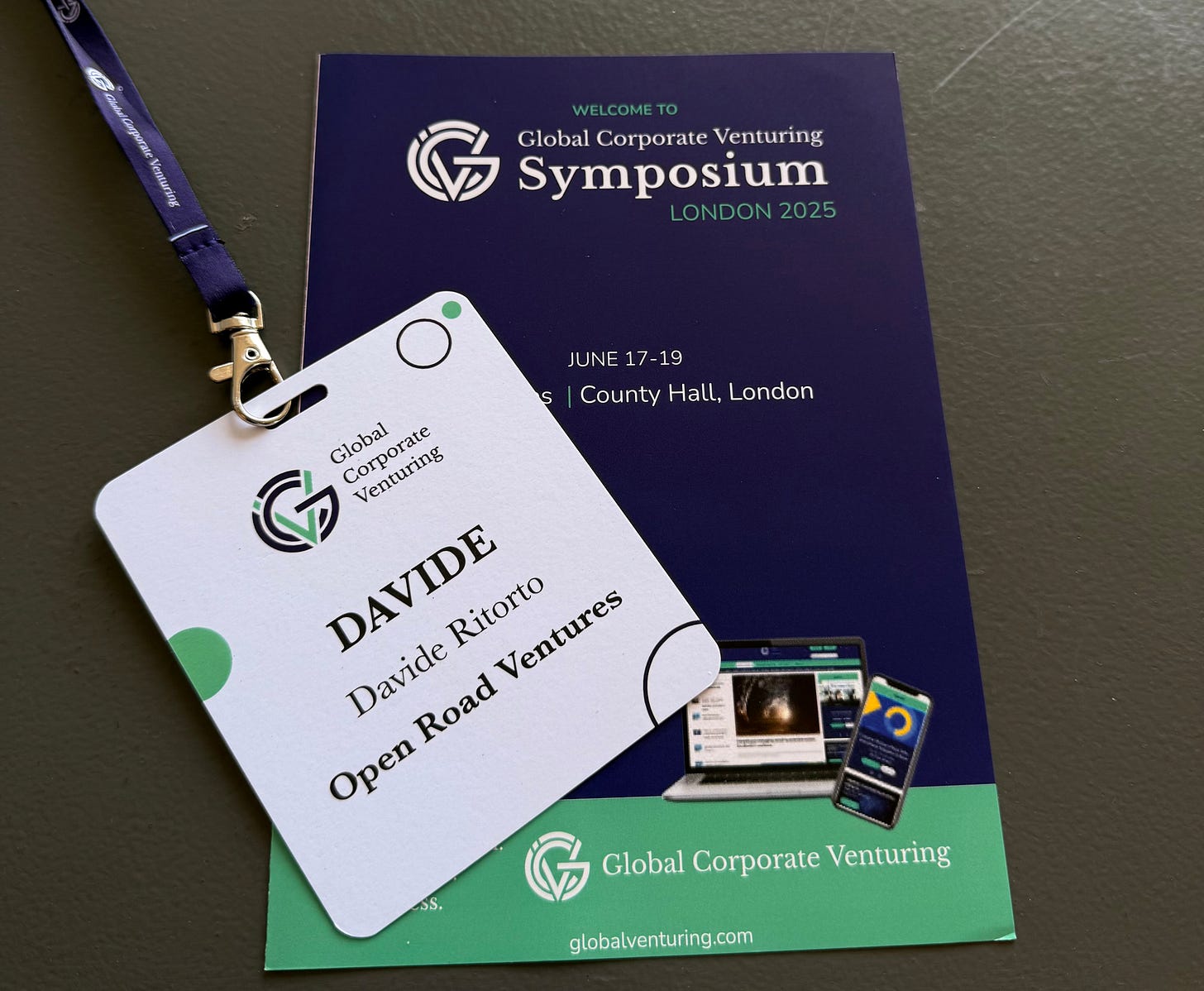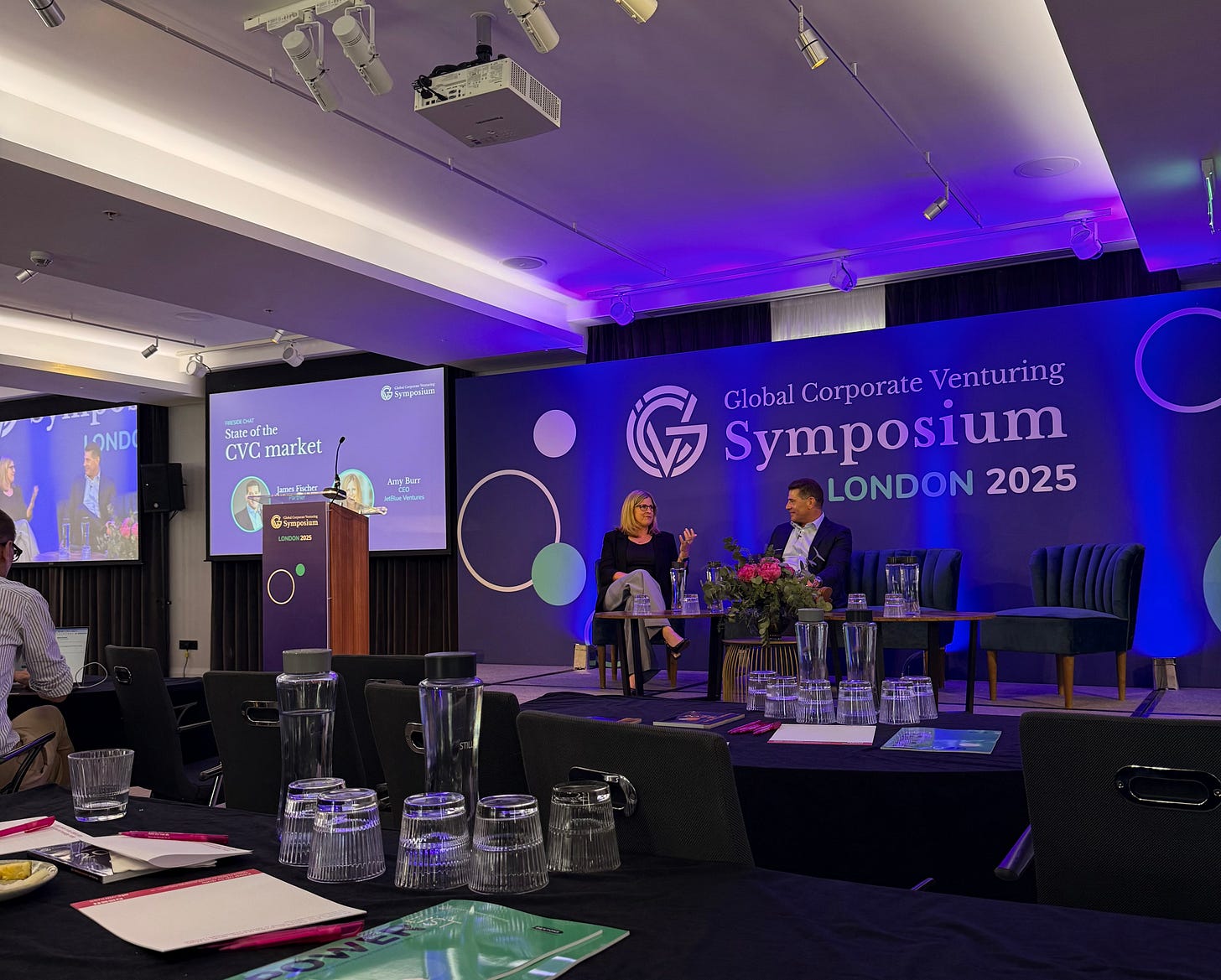Where Corporate Venturing is going: 7 signals from GCV Symposium 2025
What I learned from investors, builders, and strategists shaping the future of corporate innovation.
Previously on Open Road Ventures: in the last episode of Venturing Insights, I shared 30 charts that will help you navigate the AI transformation. If you missed it, you can catch up here!
This year, I was invited to my first major corporate venturing event — the Global Corporate Venturing Symposium in London.
For years, I’ve followed the space from the outside: articles, reports, business cases, podcast episodes. GCV 2025 was a chance to step inside. Two days with the people who are shaping how large companies invest, build, and partner to stay relevant.
GCV brought together a wide mix of people: corporate venture leaders, European and Valley investors, CEOs, innovation managers, and consultants. I even met some of the people I had first come across years ago in an HBR case study on open innovation during my MBA.
Thanks to Brella, the event’s networking app, I made the most of every slot. It worked. I had over a dozen focused conversations in 48 hours, with clear next steps in most cases.
I didn’t attend every single panel, I rather focused on the people. But for anyone interested, GCV has shared some great session recaps and short videos on their LinkedIn page.
Below are some of the key ideas I took with me.
The shift: from single tools to connected systems
One general message: Companies are moving away from standalone venturing tools.
Instead of choosing between CVC, venture building, or venture clienting, they’re mostly using all three — but with clearer intent. Some decentralise their CVCs to stay close to business needs. Others build internal studios to test new models fast. A few link venture clienting to structured PoC platforms.
The real challenge isn’t process. It’s translation: how do you connect startup logic to corporate priorities?
1. Invest or build? It depends
Few organisations have mastered building, but more are trying. If the why is clear, investing works. But if you want to reshape the core, you need to build. Investing gives portfolio breadth. Building gives directional focus.
Investing works when you need to add a capability and you have a clear Why.
Venture building fits when you want to explore a new market or rethink the core.
Building gives you choice. Investing gives you access.
Building usually starts from an internal idea you want to develop externally. Investing is the reverse: you start from the outside.
Investing is thesis-led. Building is exploratory.
Building needs more skills than investing.
Luca Gori from DLA Piper hosted a sharp panel exploring the strategic logic behind building vs investing.
Gurdeep summed it up clearly: if you don’t change your core business, you won’t survive. Venture building is a way to take early-stage risk and shape that change. CVC, by contrast, plugs in proven capabilities. He suggested to look for areas you’re good at but haven’t fully explored. And pick teams carefully. Venture building needs proximity to clients and fast iteration. Investing is broader and slower.
Jasdeep (previously a guest on my podcast) described how JLR uses venture building to create direct customer relationships — especially in spaces where their OEM model is vulnerable. In Horizon 2 and 3 plays, where the future is unclear, building lets them learn by doing. Services and new business models come into view only when you test them.
Building also lets you decide what to make. Investing forces you to adapt to what’s already out there.
Enrique framed venture building as a tool to develop and spin out internal innovations, close to the core, but not part of it.
Takeaway: Use both, if you can. Match the tool to the level of uncertainty and the kind of learning you need.
2. Venture clienting works better when the business pulls
Venture clienting = business units share problems → teams scout solutions.
CVC = venture teams find startups → try to fit them into the company.
JetBlue ran 50 PoCs this way. Only five led to investments.
BMW: you need people who can speak both corporate and startup.
Takeaway: If adoption is low after investment, fix the pull system first.
3. Venture units shape culture — and attract better people
Venture building helps spread entrepreneurial thinking.
Carried interest attracts hybrid talent — operators and VCs.
JetBlue, for example, hires from both pools and places CVC under innovation.
Amy Burr: carried interest is critical for attracting diverse talent profiles. And startup talent has different muscle memory. Corporates need that outside-in energy.
Investing also teaches you about integration pain. That helps when you later build. Fundraising for your own ventures forces empathy with startups. It also drives internal culture change. Venture building creates a protected space for experimentation. And it helps align teams around shared clients and co-creation.
Takeaway: Don’t underestimate how structure affects who you can hire.
4. Use ventures to inform the future, not just to hit return targets
InMotion Ventures uses CVC and studio activity to shape strategy — like circular mobility.
New business models feed back into long-term strategy.
From Btomorrow Ventures, Annie Goman shared a clear mandate: by 2030, 50% of revenue should come from non-nicotine products. To support this goal, they’ve made 27 investments. But driving transformation at this scale surfaces a deeper challenge: bridging the cultural gap between startups and corporates.
Also Raza Ali at IAG outlined their toolkit: invest in future challenges, build where needed, and run accelerators to test startups in live environments. That real-world friction speeds up learning.
Companies move in cycles — expansion, disruption, consolidation. Your venturing mix must reflect where you are.
5. Goals and incentives are crucial
Amy Burr of JetBlue and James Fischer from DLA Piper explored the structural side of the problem. CVCs still lack a strong secondary market for exits. That limits options.
Their CVC reports into innovation, not finance — giving them freedom to take longer views.
Amy also highlighted incentives. Carried interest is how they attract hybrid talent: people with operating experience in aviation and others from venture capital. She added that every corporate is different.
One structure won’t fit all. CVCs must reflect the business they serve.
6. Governance by design
Governance was a hot topic. Centralized vs Decentralized is often a point of discussion. As usual, it depends. But Decentralized models seem to be growing.
ABB spun out three CVCs, one per business unit. The aim: end-to-end ownership. It replaced central functions like sales, marketing, and ventures. This decentralised model pushed accountability deeper into the business.
That structure also killed off the "not invented here" mindset. But they still keep moonshots at the centre, since BUs tend to be more conservative. Investment decisions happen at division level, not via a central committee. CAPEX comes from the BUs, and they validate technologies themselves.
PTT Group coordinates six CVC arms under a Chief Innovation Officer. This ensures alignment without centralising execution.
Takeaway: Governance should match your innovation ambition. Design for both freedom and focus.
7. Deep tech, AI, and collaboration
One point was interesting. Defining Deep Tech in a scenario where everything seems Deep Tech.
LG Ventures sees deep tech as science-based innovation — physics, materials, and hardware. As an example, they’ve developed a Korean-language LLM and scout vertical AI applications. Their BD team talks regularly with BUs to guide focus areas.
Energy storage and demand management (e.g. battery charging) are current other hot themes.
What about AI Hype? JetBlue Ventures, for example, stays aligned to its core by focusing on operational deep tech, not headline-grabbing GenAI.
One thing is clear: strategic and technical alignment with internal experts is key. It’s not just pull — business units sharing needs — but also push, with venture teams proposing ideas.
ABB Ventures, for example, often initiates proposals on behalf of busy business units. They show them interesting stuff, and ask for their interest / approval.
Sony Ventures and JERA Ventures emphasised collaboration with lead investors — identifying who can help take ventures to the next level.
JLR’s Mike Smeed shared that 100% of their latest fund’s startups engaged with the company through pilots or PoCs.
Takeaway: mandates and technology evolve. Flexibility matters.
Final thought
GCV 2025 showed me that behind the frameworks, funding models, and org charts, the real story is about people trying to move large systems forward and future-proof them. In practice. With all the tension, patience, and creativity that takes.
What stayed with me is this: good venturing is not about chasing trends. It’s about creating options, for your company and your future. And that takes intent. Structure. And people who know how to bridge worlds.
I left London sharper, more connected, and more committed to helping build those bridges.
And a big thank you to James Mawson for the kind invitation and for organising such a thoughtful, well-executed event.
If you’re rethinking how your company explores or builds new ventures, I’m happy to share more.
→ Question for you: What’s working in your current mix — and what’s slowing you down?
📣 Want to be featured on Open Road Ventures?
If you’re building a tool, service, or promoting an event in the innovation landscape, check out this page to learn how to sponsor a spot in front of 1,190+ engaged innovators. Let’s brew something great together!
As usual, a soundtrack for you:









